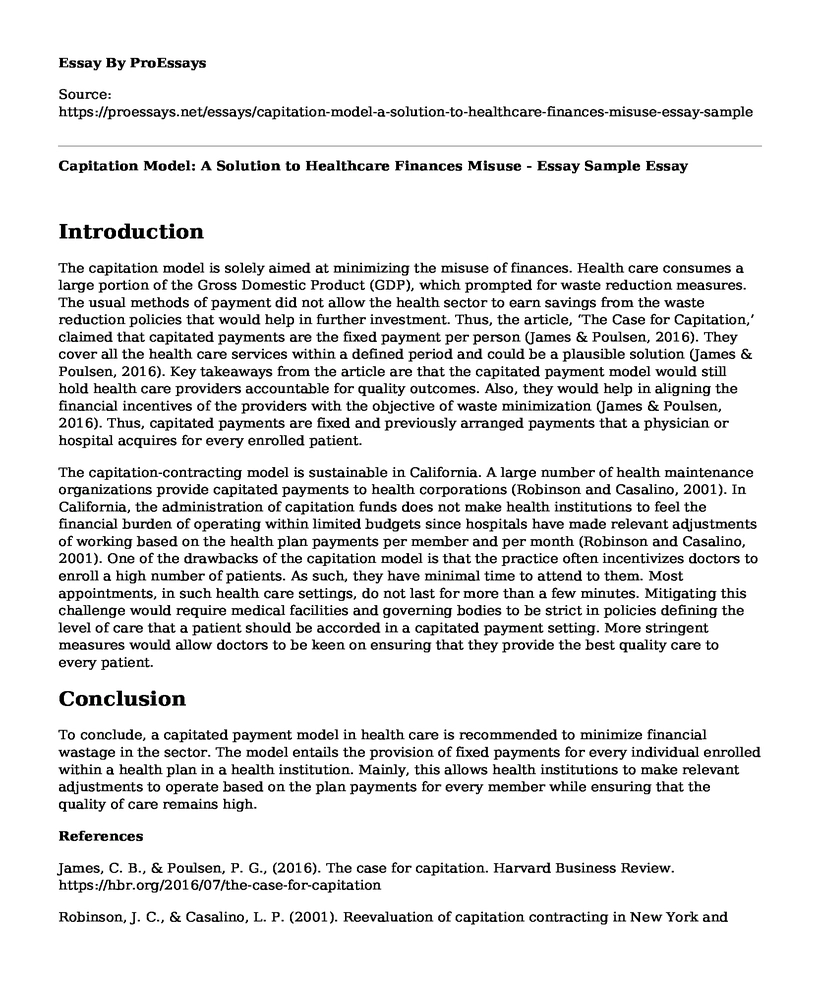Introduction
The capitation model is solely aimed at minimizing the misuse of finances. Health care consumes a large portion of the Gross Domestic Product (GDP), which prompted for waste reduction measures. The usual methods of payment did not allow the health sector to earn savings from the waste reduction policies that would help in further investment. Thus, the article, ‘The Case for Capitation,’ claimed that capitated payments are the fixed payment per person (James & Poulsen, 2016). They cover all the health care services within a defined period and could be a plausible solution (James & Poulsen, 2016). Key takeaways from the article are that the capitated payment model would still hold health care providers accountable for quality outcomes. Also, they would help in aligning the financial incentives of the providers with the objective of waste minimization (James & Poulsen, 2016). Thus, capitated payments are fixed and previously arranged payments that a physician or hospital acquires for every enrolled patient.
The capitation-contracting model is sustainable in California. A large number of health maintenance organizations provide capitated payments to health corporations (Robinson and Casalino, 2001). In California, the administration of capitation funds does not make health institutions to feel the financial burden of operating within limited budgets since hospitals have made relevant adjustments of working based on the health plan payments per member and per month (Robinson and Casalino, 2001). One of the drawbacks of the capitation model is that the practice often incentivizes doctors to enroll a high number of patients. As such, they have minimal time to attend to them. Most appointments, in such health care settings, do not last for more than a few minutes. Mitigating this challenge would require medical facilities and governing bodies to be strict in policies defining the level of care that a patient should be accorded in a capitated payment setting. More stringent measures would allow doctors to be keen on ensuring that they provide the best quality care to every patient.
Conclusion
To conclude, a capitated payment model in health care is recommended to minimize financial wastage in the sector. The model entails the provision of fixed payments for every individual enrolled within a health plan in a health institution. Mainly, this allows health institutions to make relevant adjustments to operate based on the plan payments for every member while ensuring that the quality of care remains high.
References
James, C. B., & Poulsen, P. G., (2016). The case for capitation. Harvard Business Review. https://hbr.org/2016/07/the-case-for-capitation
Robinson, J. C., & Casalino, L. P. (2001). Reevaluation of capitation contracting in New York and California. Health Affairs, 20(Suppl1), W11–W19. https://doi.org/10.1377/hlthaff.w1.11
Cite this page
Capitation Model: A Solution to Healthcare Finances Misuse - Essay Sample. (2023, Aug 28). Retrieved from https://proessays.net/essays/capitation-model-a-solution-to-healthcare-finances-misuse-essay-sample
If you are the original author of this essay and no longer wish to have it published on the ProEssays website, please click below to request its removal:
- Research Paper on the Current Status, Requirements, and the Future of Insurance Exchange
- Equal Employment Opportunity Commission
- Steps That the Bid Committee Take to Plan a Successful Bid - Essay Sample
- Essay Example on Business Leaders: Making Smart Decisions for Societal Benefits
- Long-Term Liabilities: Debts, Loans & Taxes - Essay Sample
- Essay Example on Global Management Practicum: A Tool for Success
- Essay Example on Comparing Apollo Global & American Financial Group: Key Insights for Investors







